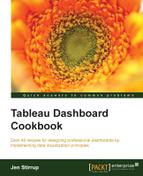In this chapter, we will cover the following recipes:
- Preparing for your first dashboard
- Showing the power of data visualization
- Connecting to data sources
- Introducing the Tableau interface
- Interacting with your first data visualization
- Sharing your visualization with the world
This chapter starts with you being a Tableau beginner, then quickly takes you forward to creating your own visualizations, and explains how to interact with the Tableau sample dashboards—how to find, open, and interact with them.
We can create visualizations by using Tableau in order to produce meaningful dashboards that communicate clearly.
Tableau has a suite of products, which are briefly described here.
Tableau Desktop is an application, which is used by individual data artists, analysts, and people who create data visualizations. It resides on the desktop, and is aimed at individual use. It can use public data, or data that is specific to the enterprise or the individual.
For more collaborative use, organizations may use Tableau Desktop along with Tableau Server, which is an enterprise solution aimed at collaboration of data visualizations. The data can be taken from anywhere, and shared within the organization via desktop or mobile browsers. Tableau Server is an on-premise solution.
Tableau Online is a hosted version of Tableau Server. It is scalable and secure, and suitable for a range of use cases, from start-ups who need to share data fast, to large global organizations who need the ability to scale.
Tableau Public is a free, online version of tableau, which is aimed at community bloggers and people who create data visualizations to share online. The data and workbooks are completely public and available.
In this book, we will focus on Tableau Desktop, because it is a very common usage of Tableau. Smaller organizations may not have Tableau Server, and organizations who cannot place their data in the cloud will not be able to use Tableau Online. Tableau Desktop is the lowest common denominator, and the book is aimed at this particular part of the suite of Tableau's family of software.
The six recipes in this chapter will explain how we can get up to speed with Tableau very quickly in order to produce dashboards that facilitate and expedite the decision making process for strategic decision makers and operational team members within your organization.
